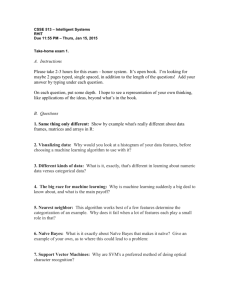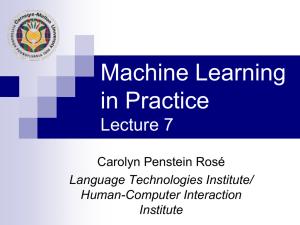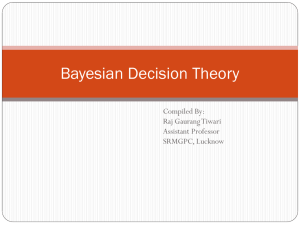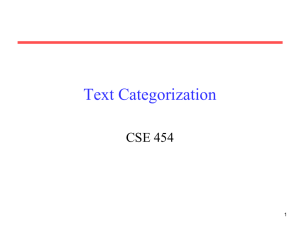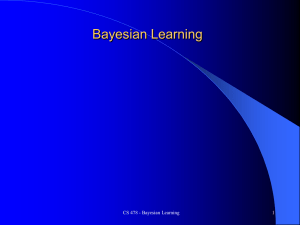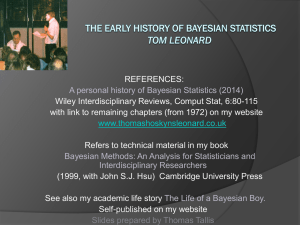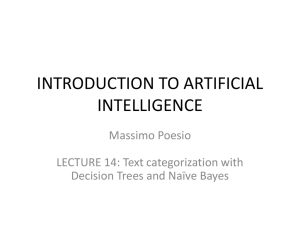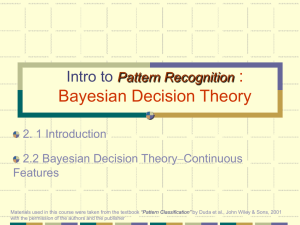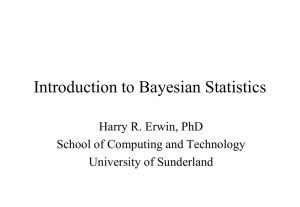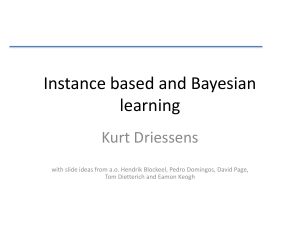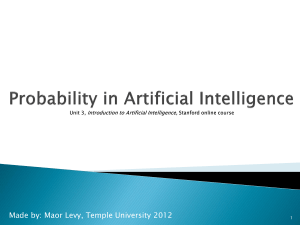Bayesian Classification
advertisement
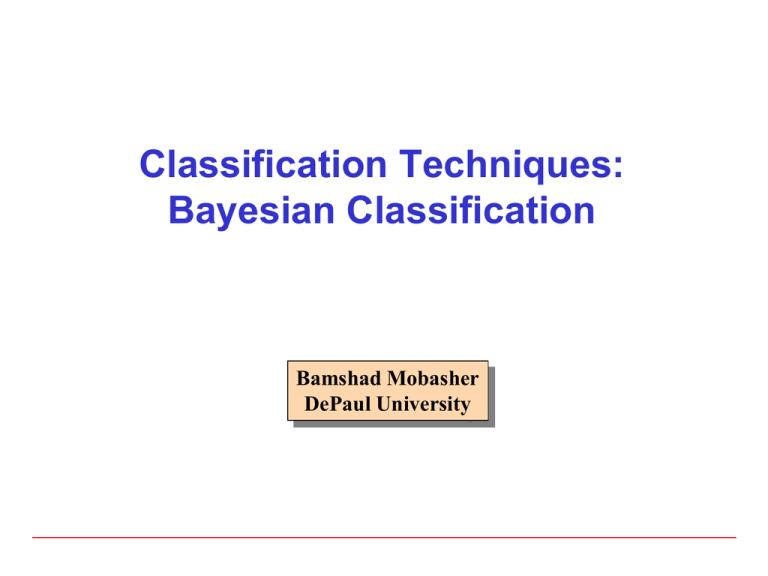
Classification Techniques:
Bayesian Classification
Bamshad Mobasher
DePaul University
Classification: 3 Step Process
1. Model construction (Learning):
Each record (instance, example) is assumed to belong to a predefined
class, as determined by one of the attributes
This attribute is called the target attribute
The values of the target attribute are the class labels
The set of all instances used for learning the model is called training set
2. Model Evaluation (Accuracy):
Estimate accuracy rate of the model based on a test set
The known labels of test instances are compared with the predicts class from model
Test set is independent of training set otherwise over-fitting will occur
3. Model Use (Classification):
The model is used to classify unseen instances (i.e., to predict the class labels for
new unclassified instances)
Predict the value of an actual attribute
2
Classification Methods
Decision Tree Induction
Bayesian Classification
K-Nearest Neighbor
Neural Networks
Support Vector Machines
Association-Based Classification
Genetic Algorithms
Many More ….
Also Ensemble Methods
3
Bayesian Learning
Bayes’s theorem plays a critical role in probabilistic learning and
classification
Uses prior probability of each class given no information about an item
Classification produces a posterior probability distribution over the possible classes
given a description of an item
The models are incremental in the sense that each training example can incrementally
increase or decrease the probability that a hypothesis is correct. Prior knowledge can
be combined with observed data
Given a data instance X with an unknown class label, H is the
hypothesis that X belongs to a specific class C
The conditional probability of hypothesis H given observation X, Pr(H|X), follows the
Bayes’s theorem:
Pr( H | X )
Pr( X | H ) Pr( H )
Pr( X )
Practical difficulty: requires initial knowledge of many probabilities
4
Basic Concepts In Probability I
P(A | B) is the probability of A given B
Assumes that B is all and only information known.
Defined by:
Bayes’s Rule:
P( A | B)
P( A B)
P( B)
A
A B
B
P( A | B)
P( B | A)
P( B A)
Direct corollary of
P( B)
P( A)
above definition
P( B) P( B | A)
P( A | B)
P( A)
P( A B)
Often written in terms of
hypothesis and evidence:
P( E | H ) P( H )
P( H | E )
P( E )
5
Basic Concepts In Probability II
A and B are independent iff:
P( A | B) P( A)
P( B | A) P( B)
These two constraints are logically equivalent
Therefore, if A and B are independent:
P( A B)
P( A | B)
P( A)
P( B)
P( A B) P( A) P( B)
6
Bayesian Classification
Let set of classes be {c1, c2,…cn}
Let E be description of an instance (e.g., vector representation)
Determine class of E by computing for each class ci
P(ci | E )
P(ci ) P( E | ci )
P( E )
P(E) can be determined since classes are complete and disjoint:
n
n
P(ci ) P( E | ci )
P(ci | E )
1
P( E )
i 1
i 1
n
P( E ) P(ci ) P( E | ci )
i 1
7
Bayesian Categorization (cont.)
Need to know:
Priors: P(ci)
and
Conditionals: P(E | ci)
P(ci) are easily estimated from data.
If ni of the examples in D are in ci,then P(ci) = ni / |D|
Assume instance is a conjunction
of binary features/attributes:
E e1 e2 em
E Outlook rain Temp cool Humidity normal Windy true
8
Naïve Bayesian Classification
Problem: Too many possible combinations (exponential in m) to
estimate all P(E | ci)
If we assume features/attributes of an instance are independent
given the class (ci) (conditionally independent)
m
P( E | ci ) P(e1 e2 em | ci ) P(e j | ci )
j 1
Therefore, we then only need to know P(ej | ci) for each feature
and category
9
Estimating Probabilities
Normally, probabilities are estimated based on observed
frequencies in the training data.
If D contains ni examples in class ci, and nij of these ni examples
contains feature/attribute ej, then:
P(e j | ci )
nij
ni
If the feature is continuous-valued, P(ej|ci) is usually computed based
on Gaussian distribution with a mean μ and standard deviation σ
g ( x, , )
and P(ej|ci) is
1
e
2
( x )2
2 2
P(e j | ci) g (e j , ci , ci )
10
Smoothing
Estimating probabilities from small training sets is error-prone:
If due only to chance, a rare feature, ek, is always false in the training data,
ci :P(ek | ci) = 0.
If ek then occurs in a test example, E, the result is that ci: P(E | ci) = 0 and
ci: P(ci | E) = 0
To account for estimation from small samples, probability
estimates are adjusted or smoothed
Laplace smoothing using an m-estimate assumes that each
feature is given a prior probability, p, that is assumed to have
been previously observed in a “virtual” sample of size m.
P(e j | ci )
nij m p
ni m
For binary features, p is simply assumed to be 0.5.
11
Naïve Bayesian Classifier - Example
Here, we have two classes C1=“yes” (Positive) and C2=“no” (Negative)
Pr(“yes”) = instances with “yes” / all instances = 9/14
If a new instance X had outlook=“sunny”, then Pr(outlook=“sunny” | “yes”) = 2/9
(since there are 9 instances with “yes” (or P) of which 2 have outlook=“sunny”)
Similarly, for humidity=“high”, Pr(humidity=“high” | “no”) = 4/5
And so on.
12
Naïve Bayes (Example Continued)
Now, given the training set, we can compute all the probabilities
Suppose we have new instance X = <sunny, mild, high, true>. How should it
be classified?
X = < sunny , mild , high , true >
Pr(X | “no”) = 3/5 . 2/5 . 4/5 . 3/5
Similarly:
Pr(X | “yes”) = (2/9 . 4/9 . 3/9 . 3/9)
13
Naïve Bayes (Example Continued)
To find out to which class X belongs we need to maximize: Pr(X | Ci).Pr(Ci),
for each class Ci (here “yes” and “no”)
X = <sunny, mild, high, true>
Pr(X | “no”).Pr(“no”) = (3/5 . 2/5 . 4/5 . 3/5) . 5/14 = 0.04
Pr(X | “yes”).Pr(“yes”) = (2/9 . 4/9 . 3/9 . 3/9) . 9/14 = 0.007
To convert these to probabilities, we can normalize by dividing each by the
sum of the two:
Pr(“no” | X) = 0.04 / (0.04 + 0.007) = 0.85
Pr(“yes” | X) = 0.007 / (0.04 + 0.007) = 0.15
Therefore the new instance X will be classified as “no”.
14
Text Naïve Bayes – Spam Example
Training
Data
D1
D2
D3
D4
D5
D6
D7
D8
D9
D10
t1
1
0
1
1
0
0
0
1
0
1
t2
1
1
0
1
1
0
1
1
0
0
t3
0
1
1
1
0
0
0
0
1
1
t4
1
0
0
1
1
1
0
1
1
0
t5
0
0
1
0
0
1
0
0
1
1
Spam
no
no
yes
yes
yes
no
yes
yes
no
yes
New email x containing t1, t4, t5
Term
t1
t2
t3
t4
t5
P(t|no)
1/4
2/4
2/4
3/4
2/4
P(t|yes)
4/6
4/6
3/6
3/6
2/6
P(no) = 0.4
P(yes) = 0.6
x = <1, 0, 0, 1, 1>
Should it be classified as spam = “yes” or spam = “no”?
Need to find P(yes | x) and P(no | x) …
15
Text Naïve Bayes - Example
New email x containing t1, t4, t5
x = <1, 0, 0, 1, 1>
Term
t1
t2
t3
t4
t5
P(yes | x) =
=
[4/6 * (1-4/6) * (1-3/6) * 3/6 * 2/6] * P(yes) / P(x)
[0.67 * 0.33 * 0.5 * 0.5 * 0.33] * 0.6 / P(x) = 0.11 / P(x)
P(no | x)
[1/4 * (1-2/4) * (1-2/4) * 3/4 * 2/4] * P(no) / P(x)
[0.25 * 0.5 * 0.5 * 0.75 * 0.5] * 0.4 / P(x) = 0.019 / P(x)
=
=
P(t|no)
1/4
2/4
2/4
3/4
2/4
P(t|yes)
4/6
4/6
3/6
3/6
2/6
P(no) = 0.4
P(yes) = 0.6
To get actual probabilities need to normalize: note that P(yes | x) + P(no | x) must be 1
0.11 / P(x) + 0.019 / P(x) = 1 P(x) = 0.11 + 0.019 = 0.129
So:
P(yes | x) = 0.11 / 0.129 = 0.853
P(no | x) = 0.019 / 0.129 = 0.147
16
Classification Techniques:
Bayesian Classification
Bamshad Mobasher
DePaul University
